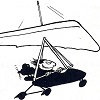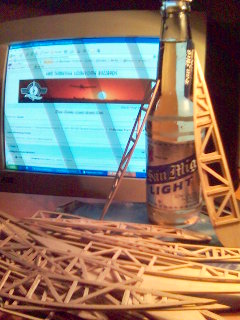|
|
 LSaupe LSaupe |
| September 4, 2020, 11:42am |
|
Flight Leader  Posts: 161
Time Online: 1 days 10 hours 40 minutes
|
Anyone out there know of an electric powered 1030? I see some nice PPG backpack power plants out there in the 28HP range. Might be an option at some point in the future as they (e-powerplants) make increase inroads in aviation. |
|
|
|
|
|
 Stilson Stilson |
| September 4, 2020, 10:33pm |
|
Flight Leader  Posts: 136
Time Online: 1 days 5 hours 36 minutes
|
I don't think the battery capability will be viable anytime soon without a quantum leap in current technology. The powered para glider (GLIDER) can take advantage of the power to climb to an altitude to find thermals and sustain itself. Just a rough ballparking of numbers, an average internal combustion engine uses about 0.5 lbs of fuel per hp per hour so at 28 hp, 14lbs. At 6 pounds per gallon 2 1/3 gallons per hour. Electrically one hp is 745.6 watts so 28 hp=20,876.8 watts, throw in some wire resistance and let's just round it to 20.9kwh per hour. Since watts=amps*volts, let's use 12volts since it's what most common high power batteries (car battery) uses. At 20,900 watts/12 volts=1742.666 amps. Figure an average car battery giving 600 cold cranking amps it would take three in parralel that can give full load power for an hour straight. They can't, and definitely can't when weighing 14 pounds. Granted there are MUCH better battery technologies out there than the lead acid example, but still none are close to even being within sight of the stadium of the playing field that combustion fuel operates at as far as power to mass.
Just my opinion. I wish there was a battery on the same level, there has been some great advances in electric motor power to weight density in the last decade if only the battery could be figured out, but I'm not holding my breath. |
|
 Logged Logged |
|
|
|
|
 radfordc radfordc |
| September 6, 2020, 1:29am |
|
 Ace Ace Posts: 1,836
Time Online: 18 days 1 hours
|
|
|
|
|
|
 LSaupe LSaupe |
| September 6, 2020, 12:00pm |
|
Flight Leader  Posts: 161
Time Online: 1 days 10 hours 40 minutes
|
|
|
|
|
|
 Bob Daly Bob Daly |
| September 6, 2020, 7:28pm |
|
Ace
Posts: 888
Time Online: 45 days 22 hours 25 minutes
|
A Skypup would seem ripe for e power. And it's mission could be motor-glider with a 10 minute climb to 1000' with multiple restarts. |
|
 Logged Logged |
|
|
|
|
 LSaupe LSaupe |
| September 6, 2020, 9:54pm |
|
Flight Leader  Posts: 161
Time Online: 1 days 10 hours 40 minutes
|
Your right, werent they initially set up for something like 20 HP, with a 277 being a bit of overkill? Relatively clean airframe as well. |
|
|
|
|
|
 Stilson Stilson |
| September 6, 2020, 10:16pm |
|
Flight Leader  Posts: 136
Time Online: 1 days 5 hours 36 minutes
|
A Skypup would seem ripe for e power. And it's mission could be motor-glider with a 10 minute climb to 1000' with multiple restarts.
This idea has some merit provided the primary intention is loitering around the field, and I think that is a very worthy intention, just don't plan on crossing any real distance and making it back the same day. I can see where electric trainers could find a market also, particularly in pattern work training, assuming they have regernative function on the prop/motor. Burn a bunch of energy taking off and climbing, circle around and regenerate while landing, that is a good idea, cross country with steady "drain" not so much. |
|
 Logged Logged |
|
|
|
|
 Antoni Antoni |
| September 7, 2020, 1:55pm |
|
 'Max, Chaser and Quik fan Ace Posts: 228
Time Online: 2 days 2 hours 53 minutes
|
... assuming they have regernative function on the prop/motor. ...
On a trainer that would mean linking a regen function to the flap function and getting the resulting feel right for a student intending to go on to a currently available non-electric aircraft. Good luck with that! Might end up like the B737 Max situation... The slower an aircraft flies, the less power it needs, the simpler an electric propulsion system it needs, the longer it can stay in the air. 1030 should be a good candidate. |
|
|
|
|
|
 Bob Daly Bob Daly |
| September 7, 2020, 4:44pm |
|
Ace
Posts: 888
Time Online: 45 days 22 hours 25 minutes
|
This idea has some merit provided the primary intention is loitering around the field, and I think that is a very worthy intention, just don't plan on crossing any real distance and making it back the same day. I can see where electric trainers could find a market also, particularly in pattern work training, assuming they have regernative function on the prop/motor. Burn a bunch of energy taking off and climbing, circle around and regenerate while landing, that is a good idea, cross country with steady "drain" not so much.
Define real distance. Thirty miles to another field where you've stashed a battery on a solar panel trickle charger could be a fun challenge. The Skypup surely glides at forty mph and has at least a 10 to 1 glide ratio. That translates to a sink rate of 4 mph. Here in upstate NY there are plenty of days April to November when 4+ knot lift abounds. |
|
 Logged Logged |
|
|
|
|
 Stilson Stilson |
| September 7, 2020, 9:46pm |
|
Flight Leader  Posts: 136
Time Online: 1 days 5 hours 36 minutes
|
That does sound like a fun challenge, I've always wanted to learn to fly gliders but never have. I'm not sure if I'd want to learn in a very low wing loading two axis control one searching out the rising air in turbulent conditions with low ground speed though. I think it would also be more correctly labeled as an electric launcher glider than electric airplane. |
|
 Logged Logged |
|
|
|
|
 viva_peru viva_peru |
| September 8, 2020, 8:45pm |
|
Wing Man  Posts: 58
Time Online: 13 days 10 hours 8 minutes
|
My feeling is that electric power will become practical at some point. Having said that, I see that a lot of the options appear to be scaled versions of what is used in R/C model flying. I am not sure that is the right way to go. For a plane like a Minimax which has a lot of built in drag the best prop would probably be of relatively large diameter, highly pitched turning at relatively low RPM. The best analogy would be a WWI fighter; draggy airplane, relatively low power with a motor which can spin a huge prop (by the standards of today). This will provide the best cruise performance but it will probably mean a somewhat longer take off run and slower climb.
I see a few issues, it appears that most of the motors offered do away with the need for a reduction system. This can severely limit their usefulness to a rather narrow selection when it comes to battery voltages and propellers. In the case of electrics, building a reliable reduction system should be relatively simple as you do not have the power pulses associated with an I.C. engine. I suspect that the motors are being designed around the propellers which are available; again, maybe not the best approach since these are mostly geared towards I.C. engines.
Maybe once you can get about 1 hour of endurance without it costing an arm and a leg people will start thinking about it as worth tinkering with. On the plus side a properly designed electric system should achieve a ease of use not possible with I.C. engines, particularly 2 strokes. |
|
|
|
|
|
 viva_peru viva_peru |
| September 9, 2020, 11:11am |
|
Wing Man  Posts: 58
Time Online: 13 days 10 hours 8 minutes
|
|
|
|
|
|
 Antoni Antoni |
| September 9, 2020, 4:03pm |
|
 'Max, Chaser and Quik fan Ace Posts: 228
Time Online: 2 days 2 hours 53 minutes
|
Reduction drives are not necessary for electric propulsion. Electric motors and their electronic controllers can handle any combination of torque versus RPM for a given power that you could want.
There are electronically controlled electric motors on the axles/wheels of railway locomotives, at the same time there are tiny electronically controlled ones which run tiny R/C aircraft propellers at silly RPM.
The *present* electric propulsion technology is easily capable of propelling a lightweight and slow 1030 MiniMax for a good distance.
It just needs someone with the theoretical and practical knowledge *and the desire to do so* to do the design and prototyping work.
The existing group of MiniMax enthusiasts may not be big enough to include such suitably talented and motivated (see what I did there?) people. |
|
|
|
|
|
 Cy V Cy V |
| September 9, 2020, 6:52pm |
|
 Ace Ace Posts: 641
Time Online: 14 days 16 hours 49 minutes
|
The technology already exists. In fact, you can buy it right now -- off the shelf. ElectraFlyer sells an electric propulsion kit that would probably work in a Mini-Max. The main problem is cost. The propulsion system plus batteries is north of $10k. http://www.electraflyer.com/price_list.php |
| Bad spellers of the world untie! |
|
|
|
|
|
 Cy V Cy V |
| September 9, 2020, 6:58pm |
|
 Ace Ace Posts: 641
Time Online: 14 days 16 hours 49 minutes
|
Upon further investigation, the ElectraFlyer propulsion kit doesn't put out enough power for a Mini-Max. It's only rated at about 20HP. A more powerful unit (and the batteries to power it) would probably be even more expensive. |
| Bad spellers of the world untie! |
|
|
|
|
|
 Stilson Stilson |
| September 9, 2020, 10:13pm |
|
Flight Leader  Posts: 136
Time Online: 1 days 5 hours 36 minutes
|
The propulsion system plus batteries is north of $10k. http://www.electraflyer.com/price_list.php
And there lies one of the major problems. Spend more for an untested system that performs worse...might be a good PR idea to make a R&D project for commercial venture looking for a tax right off while getting some publicity, but probably not the best decision for a one time builder. For half that you can get a proven 1/2vw, or for a little more than half a Verner 3 cylinder radial, and in a few years when they have reached the end of their service life rebuild it for the price of some gaskets, rings, and bearings rather than having to fork out basically the entire initial price on a battery replacement. |
|
 Logged Logged |
|
|
|
|
 ITman496 ITman496 |
| September 10, 2020, 12:40am |
|
 Ace Ace Posts: 411
Time Online: 1 days 23 hours 31 minutes
|
I have worked with enough very high powered heavy lift drone systems that I am pretty sure I could probably come up with something to make a max fly on brushless power, but the main issue, as everyone else has described, is cost and weight. I don't find the idea of spending 3-6 times the worth of the aircraft on the electric motor, with batteries that weigh a ton and don't let you fly for more then 30-40 minutes, and suffer from the legal weight penalty of counting as dry mass, unlike gasoline, which gives you a bonus 30lbs of weight.
When lithium ion gains an order of magnitude of capacity, then I think it would be extremely viable. For now.. I dunno. |
|
|
|
|
|
 LSaupe LSaupe |
| September 10, 2020, 9:42am |
|
Flight Leader  Posts: 161
Time Online: 1 days 10 hours 40 minutes
|
Would not the batteries count toward 5 gallons of fuel? Part 103 only provides a volume limit for fuel and not a weight. 5 gallons (1155 cubic inches) of batteries should be the usable limit without any restriction on weight. |
|
|
|
|
|
 Cy V Cy V |
| September 10, 2020, 1:18pm |
|
 Ace Ace Posts: 641
Time Online: 14 days 16 hours 49 minutes
|
This is interesting... Fisher Flying Products announced just yesterday that they are working on the development of three different electric propulsion systems for their aircraft. The lowest powered one would be perfect for a Mini-Max. They made the announcement in a YouTube video. It's worth watching... https://youtu.be/vpP23_zuOkM |
| Bad spellers of the world untie! |
|
|
|
|
|
 Bob Daly Bob Daly |
| September 10, 2020, 4:24pm |
|
Ace
Posts: 888
Time Online: 45 days 22 hours 25 minutes
|
Would not the batteries count toward 5 gallons of fuel? Part 103 only provides a volume limit for fuel and not a weight. 5 gallons (1155 cubic inches) of batteries should be the usable limit without any restriction on weight.
I don't believe so. Part 103 had only internal combustion engines in mind. The spirit of the rule would be violated. The only weight savings is in the electric motor. The battery/motor weight would have to be equal or less than the gas engine and it's accoutrements. |
|
 Logged Logged |
|
|
|
|
 Bob Daly Bob Daly |
| September 10, 2020, 4:33pm |
|
Ace
Posts: 888
Time Online: 45 days 22 hours 25 minutes
|
With epower, remember one is buying fuel in advance so to speak. Rather than paying $15 for 5 gallons of gas, you'll be paying less than a dollar for the electricity to charge the battery. And maintenance will be a fraction as well. I just paid $1500 to overhaul a 277. |
|
 Logged Logged |
|
|
|
|
 Phil Phil |
| September 10, 2020, 6:03pm |
|
 Ace Ace Posts: 1,071
Time Online: 15 days 4 hours 23 minutes
|
Upon further investigation, the ElectraFlyer propulsion kit doesn't put out enough power for a Mini-Max. It's only rated at about 20HP. A more powerful unit (and the batteries to power it) would probably be even more expensive.
This ElectraFlyer propulsion kit may be viable on minimax if added wing bay to compensate for lighter wing loadIng, steamlining components with carbon fiber subtitutes on other primary structure. |
|
|
|
|
|
 radfordc radfordc |
| September 10, 2020, 9:34pm |
|
 Ace Ace Posts: 1,836
Time Online: 18 days 1 hours
|
Would not the batteries count toward 5 gallons of fuel? Part 103 only provides a volume limit for fuel and not a weight. 5 gallons (1155 cubic inches) of batteries should be the usable limit without any restriction on weight.
Unfortunately, no. Some time back one of the electric power manufactures sent a letter to the FAA asking for clarification on this issue. He argued that 30 lbs of battery weight should not be included in the total weight of the ultralight. The FAA disagreed. They made a ruling that all battery weight must be included in the total weight of the ultralight, essentially making electric powered ULs illegal for all practical purposes. https://rainbowaviation.com/wp-content/uploads/2017/08/elect-103-battry-def.pdf"The FAA does not, however, concur with the assertion in your e-mail that the weight of batteries that provide power to the electric motor of an ultralight vehicle should not be included in a determination of that vehicle's empty weight. In the FAA's Aircraft Weight and Balance Handbook, FAA-H-8083-lA, the FAA defines empty weight as: The weight of the airframe, engines, all permanently installed equipment, and unusable fuel. Although batteries may indeed be used to provide power to an electric motor, the FAA does not agree that those batteries should be equated to usable fuel and excluded from an ultralight vehicle's empty weight. |
|
|
|
|
|
 LSaupe LSaupe |
| September 10, 2020, 10:12pm |
|
Flight Leader  Posts: 161
Time Online: 1 days 10 hours 40 minutes
|
Dang. That is more than a disincentive. |
|
|
|
|
|
 ITman496 ITman496 |
| September 13, 2020, 3:43am |
|
 Ace Ace Posts: 411
Time Online: 1 days 23 hours 31 minutes
|
It doesn't matter that much, as this one: http://mymobilemms.com/OFFTHEGRIDWATER.CA/Brushless-Motor/50KW-BLDC-Brushless-Motor-150hp-MotorWeigh only 6.4kg, with a motor controller weight of 1.2kg http://www.esccontroller.com/s.....or-electric-car.htmlplus lets say 1-2kg of misc parts, means something vastly overkill for a minimax weighs in at 9.6kg or 21ish pounds. A rotax of much less power, the 582 for example, weighs 110lbs presumably also without a propeller. This means that you have saved 89lbs, and I'm sure its likely even more if you factor in exhaust and lots of other stuff. So in that regard, getting an extra 30lbs for the loss of fuel doesn't really matter, you've already smashed that in engine savings. However, even 89lbs (lets call it 100lbs of batteries, since we can say you saved weight not having a fuel pump, fuel lines, heat shielding, fuel tank, etc) doesn't get you much. A tesla battery (a practical source of high performance cells) has a battery energy density of ~240wh/kg or lets say 110wh/lb. So lets round that down to 100wh/lb to account for the weight of battery support structure, monitoring and balancing systems, case, protection, wiring, coolant, whatever. Your 100lb of battery becomes only 10kwh. Assuming the average cruise power lets just say is 25hp. It probably isnt, but it will work for this example, the numbers are totally fudged as it is in favor of electric and it still will be useless. 25hp is 18.6kw. With 10kwh of battery power, you get roughly 30 minutes of runtime. Except you dont, that's 100-0%. If you do a more realistic charge cycle of leaving the last 15% in to not damage the battery, and a 20% on top of that to have reserve power, you only get 65% of that, or 20 minutes. On top of that, you're using more power than that to get into the air.. So once you're going, you may only have 10 minutes to cruise before you have to find a spot to set down. Until batteries are an order of magnitude better, and that 10 minutes turns to 100, I don't think its worth fighting the FAA over 30lbs. Getting 30lbs in the above calculation would give you an additional 3kw, or an additional 9.6 minutes of cruise time. I don't know about you, but 19.6 minutes of cruise time doesn't sound that fun. Again all these numbers are completely napkin math, but I figure its close enough to realize that its just not gonna happen until we get some better battery densities. |
|
|
|
|
|
 radfordc radfordc |
| September 13, 2020, 2:46pm |
|
 Ace Ace Posts: 1,836
Time Online: 18 days 1 hours
|
Until batteries are an order of magnitude better, and that 10 minutes turns to 100, I don't think its worth fighting the FAA over 30lbs. Getting 30lbs in the above calculation would give you an additional 3kw, or an additional 9.6 minutes of cruise time. I don't know about you, but 19.6 minutes of cruise time doesn't sound that fun.
The guy who asked for the 30 lb allowance was building an electric launched motor glider. Just needed enough power to get up to soaring altitude. Not sure it ever was fully developed. https://youtu.be/u-PV_ZBnJsM |
|
|
|
|
|
 ITman496 ITman496 |
| September 13, 2020, 4:24pm |
|
 Ace Ace Posts: 411
Time Online: 1 days 23 hours 31 minutes
|
That might work out.. I didn't think about glider uses. |
|
|
|
|
|
 Greg Doe Greg Doe |
| September 14, 2020, 1:15am |
|
Ace
Posts: 256
Time Online: 40 days 14 hours 20 minutes
|
There is a beautiful self launch glider made in Italy called a Silent. It's has two LiPo batteries that are capable of a takeoff and 3 more climbs. This is one example. There are other electric self launch gliders as well. I'm sure that the motor battery technology could be applied to ultralights like the Mini Max, but it would be expensive. Over the years there have been many self launch gliders that had Rotax, and similar engines for self launching. Some applications were nestled in the tail boom, and cranked up and out for power. Some had the engine in the nose, with folding propeller blades. So the power from electric, and gas is similar, but the flight profile for our ultralights requires the engine/motor to run continuously, whereas a glider spends most of it's time soaring. So the problem for us is flight duration. The good news is it's always getting better. |
|
|
|
|
|
 joe.scalet joe.scalet |
| September 17, 2020, 5:43pm |
|
 Flight Leader  Posts: 155
Time Online: 2 days 1 hours 58 minutes
|
The Silent is a beautiful aircraft. I shared my hangar with one for several years. After watching it many times my answer to anyone who wants to use electric power on an airplane is go for it. You may not get the range, climb or endurance of fossil fuel but so what? Its a hobby! Enjoy it. Coming up with a system you can afford is part of the fun.
BTW the original Silent used NiMH batteries. |
|
|
|
|
|
 ITman496 ITman496 |
| September 17, 2020, 5:53pm |
|
 Ace Ace Posts: 411
Time Online: 1 days 23 hours 31 minutes
|
I think in the usage case of a glider there is a point to be made for electric. However on a normal aircraft that does not rely on gliding I imagine its simultaneously more expensive and worse then fuel. At least at these small uncertified scales.. Those large batteries and large motors and especially controllers do not come cheap  |
|
|
|
|
|
|



